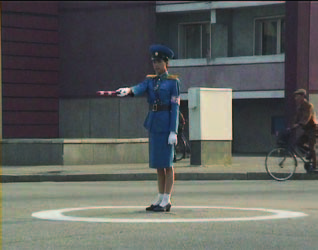If you don’t want to be discriminated, why do you accept discrimination against others? Racism can be unlearned – read how a diversity teacher changes the rules.
“We have created an environment in the United States for black people in which they feel the way Jews felt in Nazi Germany,” claims Jane Elliott, America’s most charismatic diversity trainer. Such a statement may seem unbelievable, but the film Blue Eyed Elliott has strong arguments to support Elliott‘s point of view.
“What is your name? Can you read that?” Jane Elliott doesn‘t smile as she questions a workshop participant. A blue-eyed one. “Sure.” He answers with a tentative smile. “What does that say?” – “Louis A. Wright,” he replies, a bit confused. “Cross it out and write it so I can read it.” Louis is getting angry. He doesn’t know why he is being treated this way. He refuses to sign the form. “Are you the security person?” Elliott asks a black woman in a uniform who is standing nearby. “He isn‘t going to follow the rules, so he isn‘t going to stay.” she continues. “Get him out of here.”
But in a few minutes he’s back. He has thought it over. Now he is going to behave and he is ready to do anything he is asked. So are the other participants. They are divided into two groups. “Blue eyed white folks today are going to learn more than they want to know,” informs Elliot. “They will walk in the moccasins of a person of color for a day.”
“I’m going to assign these people, on the basis of their eye color, all the negative traits that we have assigned to females, to people of color, to gays and lesbians, to people who have disabilities of any kind, to those who are obviously physically different.”
The blue-eyed people get strips of green cloth that are fastened to the neck as collars, so that they can be easily recognized. The strips are uncomfortable. Seventeen people are ushered into a room without windows, with only three chairs. They will find out why in a couple of minutes.
White subconscious
Jane Elliott calls herself a “diversity trainer” and describes her work as “inoculation against discrimination.” However, inoculation protects us from viruses in advance, whereas Elliott fights the “live virus of racism” that we already have inside our brains.
“If you as a white person would be happy to receive the same treatment that our black citizens do, please stand” Elliott announces at the beginning of the workshop. Nobody gets up. “You know you don‘t want it for you. So why are you accepting it or allowing to happen for others?”
In his autobiography, Malcolm X said that white peoples’ belief that they are superior in some way is “so deeply rooted that these things are in the national White subconscious.” He explained “Many Whites are even actually unaware of their own racism, until they face some test, and then their racism emerges in one form or another.”
Elliott cites as an example of this White subconscious the lower expectations of black people and the way they are forced to “live down” to these expectations. For instance, when we call a black adult male a “boy”, although he may be over seventy.
A stressful look in the mirror
From the windowless chamber, the blue-eyed people are taken to a bigger room. They sit on the floor, next to the brown-eyed ones who sit in chairs. They are treated with rudeness and malice. Elliott demonstrates her superiority. “You don‘t understand. Your low IQ is one of the problems I‘ll have to deal with today.” She raises her voice to make the blue-eyed feel uncomfortable. She gives fast, assertive orders. Afterwards, she starts to discuss the topic of stress. A blue-eyed woman admits that the experiment is stressful for her.
“Then you don’t know what stress is” says a black man sitting among the brown-eyed group. Stress is to know that when you send your son or daughter to school, no matter what they say or do, it’s never good enough. A black woman next to him says she is one of the two black teachers in a school with sixty teachers. “Every morning when I look in my mirror, that’s where my stress begins. Sure I am treated differently than the white teachers.”
I do what Hitler did
After the workshop the blue-eyed participants looked confused and sad. “If you are so angry after two and a half hours, can you imagine what it must be like to live with this feeling for a lifetime?”
Elliott came across the idea for her workshops from reading about how the Nazis treated their victims. One of the ways they decided who went into the gas chamber during the Holocaust was by looking at eye color. “I decided on the day after Martin Luther King was killed that I would do what Hitler did.” At the time, Elliott was an elementary-school teacher in her allwhite hometown of Riceville, Iowa.
I picked out a group of children from the third grade on the basis of a physical characteristic over which they had no control. One group was placed on top, the rest on the bottom. Elliott was horrified when she saw how quickly the kids became what she told them they were. Within thirty minutes, a blue-eyed girl had regressed from a self-confident, carefree, excited little girl to a frightened, uncertain person. On the other hand, a brown-eyed boy became self-confident, high and mighty. Suddenly, brown-eyed boys with dyslexia could read words that Elliott “knew they couldn’t read” and spell words that she “knew they couldn’t spell.”
Racism is learned
But the teacher paid a high price for expressing her anti-racist views. After the experiment she received vicious calls and five hundred death threats by mail. Some parents of Elliott’s pupils demanded to move their children from a “nigger-lover’s class.” Her parents’ business went bankrupt because they lost all their customers. She and her family have experienced cruel racism throughout their lives. Despite the horrible setbacks, Elliott continues to work in the fight against racism. “To sit and do nothing is to cooperate with the oppressor,” she emphasizes in the film. The most important thing for her is that no one is born with racism: “It is learned. And if it is learned, it can be unlearned as well.”











